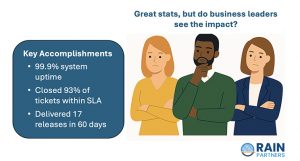“You gotta understand the business!” — What it really means know the business

(The following is an excerpt from our book The 11 Secrets of Highly Influential IT Leaders.)
“You gotta understand the business!”
In the IT world, we’ve been hearing this call, this commandment, to IT leaders for as long as I can remember. But despite constant repetition, it still seems to be a chronic problem for many IT leaders. A personal experience may be useful for illustrating the point.
I spend a great deal of time helping senior IT leaders and their business colleagues envision the strategic application of technology to their business. As part of this activity I supply my clients with a pre-consult checklist. It’s a simple list of materials I ask clients to assemble for me, so that I can learn as much as possible about them, their organization and their industry before our in-person meeting.
The list of requested materials varies based on the nature of the work, but almost always includes several pretty obvious items. Typically these include:
- An industry overview (as seen by their company)
- The company mission and vision statements
- Current business strategy
- A description of their strategic advantage(s) in the marketplace or their Unique Sales Proposition (USP)
- IT strategy
- IT organization mode
- IT service delivery model
- IT service scorecard
Does it surprise you to learn that less than 10% have ever sent me all the materials prior to our meeting? 75% provide me with nearly nothing at all.
In some cases, the IT leaders simply don’t have access to the materials. In others, they claim that such materials don’t quite exist. In the majority of cases I hear, “It’s all pretty much up in the air right now and that’s why we want to speak with you”.
The reasons however, don’t really matter. The net result is still the same.
In company after company, before I ever have an opportunity to talk about technology-based opportunities or strategies (as planned), I spend a great deal of time teasing out of the IT leaders AND their business colleagues the essential information about their business required to gain a real understanding of their company and their unique situation.
At first, I thought it was just my clients that were challenged in this way. Over time, I learned that this is a widespread and very common situation. So I looked into it more carefully.
Why IT Leaders Rarely “Understand the Business”
What I found was that nearly all IT leaders know they need to understand the business. That’s beyond obvious. However, what they don’t quite understand is exactly what that means. In fact, the vast majority of IT leaders interpret the phrase “understand the business” to mean: understand the priorities, needs, wants and requirements of the business area for which they are responsible.
And while this is not wrong, it is not a deep enough understanding of the business for achieving and maintaining boardroom-level presence. And it certainly isn’t a sufficient level of understanding to effectively support you in your attempts to influence board-level executives.
This brings me to the obvious question: What then exactly does it mean to “understand the business”?
What are those special things that IT leaders need to know about their business in order to be able to really play at the most senior levels?
Here are the answers to these important questions. These are the table-stakes knowledge and information you need to have at the ready in order to effectively play in the influence game.
The Three Dimensions of Business Understanding
A business (like any organizational unit) is a complex web of people, processes, ideas, history, money and so much more. It’s therefore helpful to have a method for getting our arms around it. I use a method called the three dimensions of business understanding.
These three dimensions don’t so much break down and categorize the business— a simple functional model can do that. It’s more that they tell the inside story of the business. They expose the essence of the business and what makes it unique. The three dimensions of business understanding are:
- The Business/Profit Model
- The Operating Model of the Business
- The Competitive Position
1. The Business / Profit Model
The business/profit model highlights the key profit drivers for the company. It provides insight into the relationship between revenues and costs, how they relate in terms of the company’s operations, and ultimately what products and services are most profitable. It highlights cost advantages and disadvantages. Multiple companies may operate in the same general market space, but their specific business model and profit drivers differ substantially.
2. The Operating Model
Closely related to the basic business and profit model is the operating model. The operating model is first and foremost the living, breathing, working instantiation of the Business / Profit Model we just covered. But your company’s operating model is more than just that. The operating model encompasses your company’s philosophy, approach, and methods of operation. Finally, the operating model expresses how your organization uniquely gets things done.
3. The Competitive Position
The final dimension of business understanding is competitive positioning. Competitive positioning describes how your company is uniquely equipped and configured to sell and service customers as opposed to its competitors.
Why Are These Three Dimensions So Important?
From M&A activity to operating systems upgrades, knowledge of your organization’s Business Model, Operating Model and Competitive Positioning sets you up to deal with the senior leadership of your organization as a peer that is in touch with the most important aspects of the business. Knowledge of these three dimensions takes you beyond a basic understanding of business operations and into the heart of the organization’s being.
With a command of these three dimensions of business understanding you put yourself in the best possible position to influence your peers and bosses, because you will be speaking from the same perspective as them.
How to “Understand the Business”
Do whatever it takes to get a solid hold on your company’s business model, operating model and competitive positioning.
- Read all of your company’s financial statements and filings.
- Get copies of all of your operational and analytical reports.
- Read trade journals, websites and analyst reports.
- Attend industry conferences.
- Join peer groups.
- Ask questions.
- Know your business and operating model cold.
- And finally, become a devoted follower of your company’s competitive positioning. It is likely to feature prominently in your influence-seeking interactions.
With your newly acquired knowledge of the three dimensions of business understanding in hand, you are ready to put them to work in your upcoming efforts to form, and sell, your strategy.


